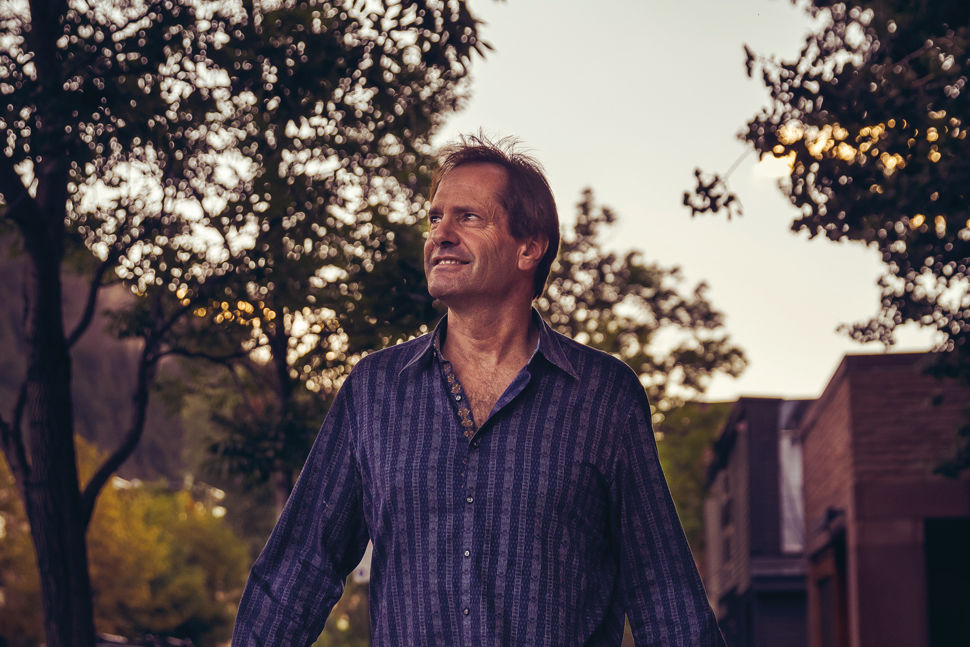
"A$pen: The Series" Is Ultimate Passion Project
In the world of Greg Simmons, perseverance is everything. Consider a moment in 2003. Simmons was on a lunch date with a beautiful woman at the Ivy, an iconic Hollywood eatery, when a call came in. It was from HBO, regarding its then-annual US Comedy Arts Festival in Aspen. Simmons had applied to get his proposed TV comedy, A$pen: The Series, into next year’s festival, and HBO was turning him down. “What do you mean we didn’t get in?” he said and launched into a long argument about why the show should be accepted. Did it work? It did not. Did the woman stick around? She did not. Did Simmons give up? He did not—because Greg Simmons doesn’t give up. Not ever.
Fast-forward 15 years. In the interim—one that saw the TV landscape changed by Breaking Bad, Lost, The Wire, The Office, Modern Family, and Veep, to name a few—Simmons has developed his show with his own money, hired dozens of models to promote it, and tried to crash not only the HBO fest in Aspen, but also the Sundance Film Festival and the Torino Winter Olympics. He’s thrown legendary parties, developed a piece of the show into a voyeuristic web series about fashion models, made new friends and a few enemies, survived a stroke at the age of 43, and, like his show, refused to die. In March of this year, Simmons finally held a launch party for the first two episodes, which appeared not on HBO but on Aspen’s own Grassroots TV. The party was at the Aspen club Bootsy Bellows, in a downtown space that was still the Crystal Palace dinner theater when Simmons began his quest. People were partying like it’s 1999, and if the show was only airing on local TV, so what? Simmons had been on hiatus for the better part of four years. What mattered at the moment was that he—and the show—was back.
It’s said that falling in love is always expensive. So it’s been for Simmons, who in 2002 fell in love with comedy at HBO’s Aspen festival. “I got totally caught up in it,” he says. A real estate developer, Simmons decided a few months later that he would stop making houses and start making a TV comedy about the home he loved.
Thus A$pen: The Series was born. Instead of seeking advice about how people make TV shows—that’s just not his style—Simmons got together with his friend Scott Snare and conducted hundreds of interviews in Aspen “to get the funny out of people.” Tall and gregarious, with a ready smile and an aura of enthusiasm, Simmons assumed this would be the easy part. What he learned was that most people aren’t funny. (Dying is easy, goes the saying, comedy is hard.) “After doing the interviews, I had a goose egg,” he says. “I didn’t see a story or a cast of characters.” But then during a flight to the East Coast, Simmons wrote out his ideas for the show at 35,000 feet. They encompassed different versions of himself and people he knew.
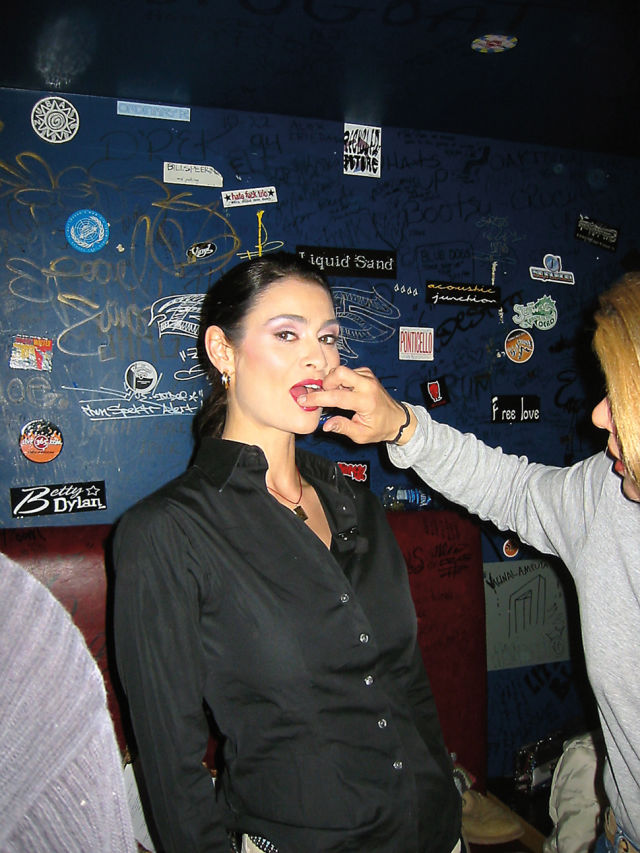
Charlotte Lewis before a cast reading in Aspen
Image: Courtesy: Greg Simmons
Next, he used an Aspen connection to get to Paul Fisher, a famed modeling agent, who helped Simmons put together what he calls a “writers’ workshop” to come up with alternative treatments. “One guy was a former porn star, Billy Wirth was a big name, Paul Fisher was a big name,” says Simmons of those who participated. “There aren’t any other shows out there with seven creators,” he adds with obvious pride.
Simmons split the group into two factions, and each wrote a treatment, working from the ideas Simmons had sketched out on the plane. He then picked the elements he liked best from each. Never once did he doubt his ability to make the right call. “I think we came up with a unique concept,” he says. He then had the team write the pilot script from his reworked treatment. Afterward, Hollywood producer Gary Michael Walters introduced Simmons to Larry Levy, a former Seinfeld writer, whom Simmons hired to do a rewrite. There was now a pilot script.
At this point, we should step back from Simmons’s story to discuss how a TV show is typically developed in Hollywood—because there are established steps. These go, roughly, as follows: a writer and production company develop a pitch; they take the pitch to a network (the folks with the money); the network either passes on or buys the show. But “buy” has a special meaning. What the network really does is pay the writer to write the pilot episode, while providing voluminous input (a.k.a. “notes”) all along the way. Then even if the network decides to shoot the pilot—a step that often doesn’t happen—it might still decide to kill the show before the pilot even airs.
Thus, in the turtles-to-the-sea process that is TV development, millions of dollars are spent to make television episodes that never see the light of day. But that’s not what’s important here. All those “notes” to the writer give the network buy-in on a project, making network executives more likely to produce and air a show they consider “theirs.” Or, as one Hollywood writer puts it, “They like to pee on the territory so it smells familiar.”
Simmons could not care less how it’s normally done. Says Derek Goodall, Simmons’s producing partner and editor, “Greg’s got a singular approach, to put it mildly.” Adds Levy, “I tried to tell him that’s not the way things are done. He didn’t care.”
No, Simmons was always going to do it his way if it killed him—it almost did—and he has never wavered from this position. Consider that just this year he had a meeting with famed Marshall Field’s heir and Hollywood producer Ted Field, who suggested Simmons take his idea to the networks in the traditional manner. All he had to do was ditch everything he’d done to that point. Simmons turned him down. As far as he is concerned, the show is his, and he’s not going to give up control to anyone. “The story behind the development of it—that it was developed from the comedy festival, and an Aspen local goes to Hollywood and creates a show—there’s not another story on the planet like it,” says Simmons. “And somebody asks me to scrap that and take it to a showrunner? Fuck that shit.”
Once Simmons had his pilot script, he cast the show and brought everyone to Aspen for the 2004 Comedy Arts Festival, even though, as we’ve already seen, he was not part of the actual event. Instead, he staged readings nearby. “We had a pilot script of a scripted show named A$pen: The Series,” says Simmons, implying this was reason enough to get into the festival—which was in Aspen, after all. Why did he believe this approach would work? “I knew [HBO executive] Stu Smiley,” says Simmons. “And I didn’t know the industry. Yet.”
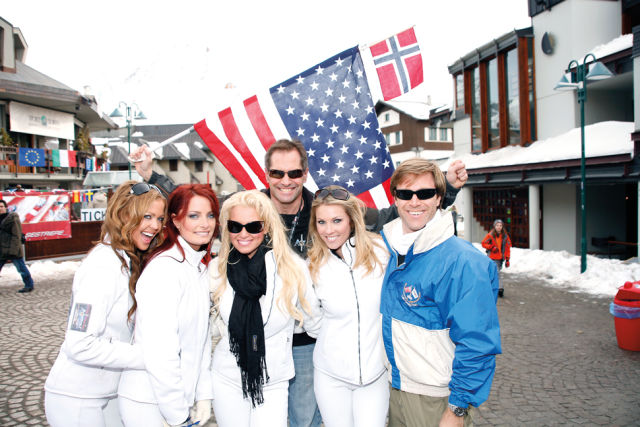
Simmons (at rear) with Carrie Stroupe, Kasey Head, Tina Jordan, Ashley Smith, and Steve Huntsman at the Torino Olympics
Image: Courtesy: Greg Simmons
He also assembled an entourage that included a rotund ex-wrestler/rapper named Casanova Ace, a lot of models, and some Vegas dancers. What did showgirls have to do with Aspen? Well, Simmons is a fan of the early-’90s show In Living Color, which had a dance troupe called the Fly Girls (Jennifer Lopez got her start in it), and he saw no reason why A$pen: The Series shouldn’t have the same. In fact, you could call the whole project an amalgamation of everything Simmons loves most in life: Aspen, skiing, beautiful women, laughing, extreme sports, travel, and music.
So what is the show actually about? It centers around Walter Montgomery, a billionaire in the midst of a midlife crisis. Of course, he moves to Aspen, where he quickly learns that he’s lost all his money. No matter; on his 40th birthday his beautiful girlfriend, January, gives Walter the gift of a reality show about his life—which he now plans to sell in order to regain his wealth. There’s also January’s BFF, Madison, an actress in recovery, and Madison’s little sister, Macy, who runs a website called Sneak-a-Peak (you can guess). Ducky, a trustfunder; James, a ski patroller; and Lenny, a desperate Hollywood writer (as if there’s any other kind) round out the regulars.
If none of this sounds like the Aspen you know, you might be missing the point. Says writer Levy, “I would really like people to appreciate these characters for their humanity.” Adds Aspen-born Allyn Harvey, the show’s new marketing director, “The idea of a reality show being created on Red Mountain—is that really so implausible?”
In the midst of his other efforts, Simmons tried a unique approach to get the show noticed: He created a reality show about groups of actors competing to make the best version of A$pen: The Series, which he called Making America’s Next Hit Show. It aired on Spike and Comedy Central—because Simmons paid the networks to air it. It was, in essence, an extended commercial for the thing Simmons really wanted to make. “It’s a reality show about a sitcom that’s about a reality show—that is a talk show, with dancers,” said one wag at the time.
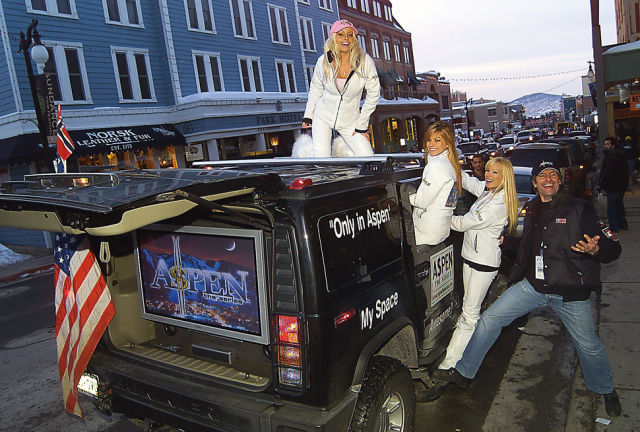
Simmons with models and the infamous Hummer at the Sundance Film Festival
Image: Courtesy: Greg Simmons
Next, Simmons hit the road with his entourage of models, causing stirs (including with law enforcement) at Sundance and the Olympics in Torino, and developing a web series based on the show’s Sneak-a-Peak. He returned to Aspen at the end of 2006. It had been a rough year, what with the show still in limbo and the death of his father. Then, in December, Simmons had his stroke.
Had the show done him in? Simmons points out that his brother had a stroke at age 42 without the benefit of trying to make a TV show. If anything, the show may have given Simmons a reason to live. “I had to relearn to eat, walk, and talk,” he says. And yet a half year later he was at Cannes, promoting A$pen: The Series. The stroke also gave him a laughing condition—he would laugh for no reason—that eventually subsided. Death is easy; comedy is hard.
But Simmons inherited more from his family than susceptibility to strokes. His father, Warren, was a legendary entrepreneur who founded several businesses while working as a Pan Am pilot, then went on to develop Pier 39, one of San Francisco’s busiest tourist attractions. After that, Warren founded a Mexican restaurant that, in 10 short years, grew into a chain of 38. When he ran short of cranberries for the restaurant, he solved the problem by buying acres of cranberries in Chile and eventually became the world’s largest grower of cranberries. In other words, Greg was raised to take risks and find a way to make things work. The show “is very much a Warren Simmons-ism,” says Greg, who calls creating a TV series “the ultimate entrepreneurial challenge.”

Models promoting the series at the Cannes Film Festival
Image: Courtesy: Greg Simmons
Back from Cannes, still without any significant interest, Simmons took to parking his Hummer—itself a marketing device, festooned with the A$pen: The Series logo—in front of the entrances to Hollywood movie studios, then waving at the entering executives with his typical enthusiasm. Not long after, the short-lived reality show Secrets of Aspen debuted on VH1. A coincidence? Simmons wonders.
At this point, now more than four years in, Simmons recalls, “I got tired of asking permission.” He would finance his pilot—with his own money. This simply isn’t done. Then again, most of what Simmons had done up to now hadn’t been done until he did it. He hired more writers to punch up the script, and, with an already substantial pre-production budget spent, paid an additional (yet incredibly frugal) $300,000 to shoot the pilot, saving money by using a house in Los Angeles as a stand-in for Aspen. Simmons calls the production experience “the funnest week of my life.”
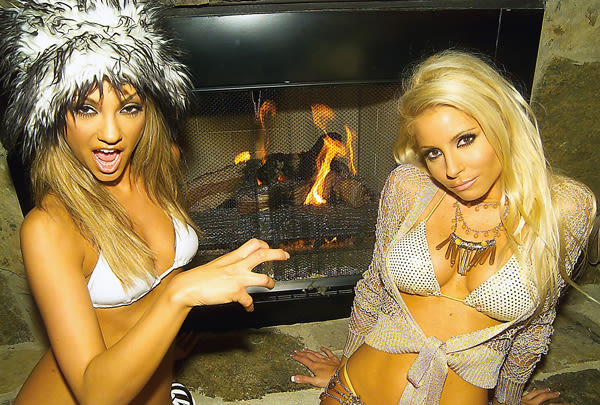
Models Colleen Kennedy and Mary Riley at Sundance
Image: Courtesy: Greg Simmons
The pilot, though, still didn’t get him a distribution deal, so a little more than a year later, after lining up some outside financing, he shot a second episode. Of course, by this time many of his actors had moved on, so while the characters were roughly the same, most of the actors were not. Simmons intended to shoot more episodes but lost his outside financing and had to shut the production down.
What did he do next? He threw a huge party at the Castle Ivar in LA, replete with scantily clad models. By now, you might ask what the point was—and conclude that the models were the point. No, he insists. “I threw parties to build the brand in LA to get the show done. It was not to get me laid.”
By 2012, Simmons needed a break. Making the show, then promoting it for another five years had been an “extraordinary heavy-lift experience,” he says, and he was exhausted. A$pen: The Series went into hibernation. Simmons did a little social media for the project for two years, then stepped back even from that.
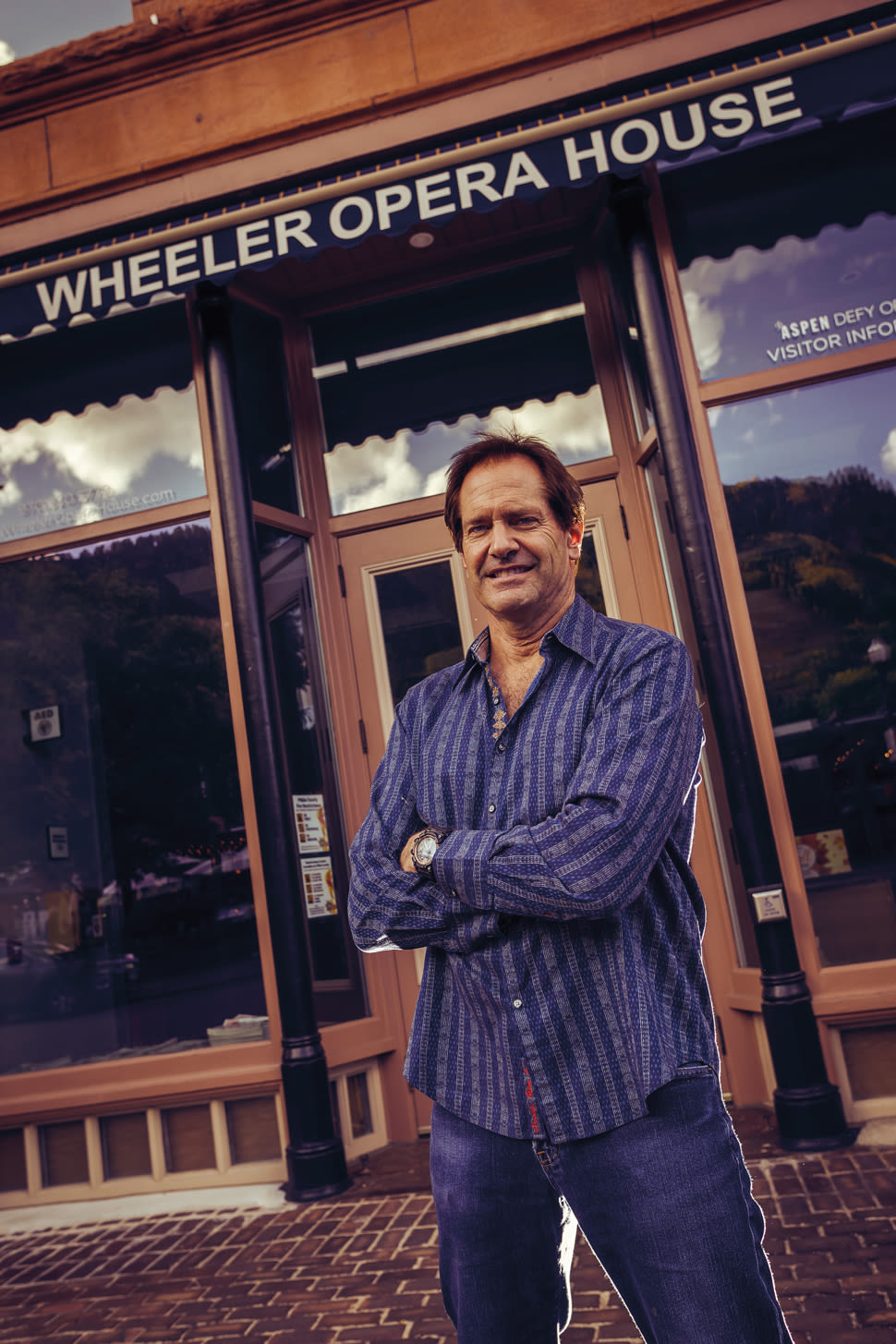
Simmons in Aspen today
Image: Nick Tininenko
Then, on New Year’s Day 2018, he took stock of his life—as many do at the turn of a year—and decided to pick it back up again. He hired Harvey as marketing director to handle the show’s social media push, focusing on Facebook and Instagram. The analytics produced interesting data about where the show resonated: the Roaring Fork Valley, for one, but also Dallas (especially the north side), and Miami. The push has also been successful internationally, most recently in Mexico City. Harvey thinks the data will allow Simmons to have a conversation about the show with someone who counts. It also might ultimately provide a new distribution channel, one that circumvents Hollywood altogether. Given the rapid changes of the last decade, it’s no more far-fetched than the idea that someone would create a reality show on Red Mountain. Says Goodall, “I’d never put anything past Greg.”
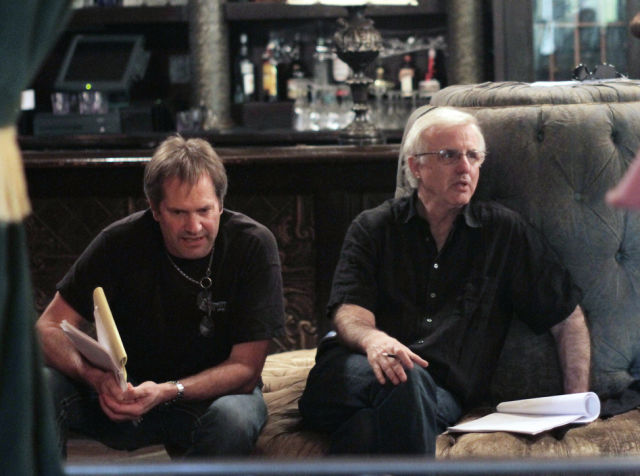
Simmons and former Seinfeld writer Larry Levy at work
Image: Courtesy: Greg Simmons
The folks who have worked with Simmons over the past 15 years fervently hope he succeeds. They all speak to his overt passion for the project and his perseverance—even if they question his sanity. “Greg’s determination is just amazing,” says Levy, who considers him as much a friend as a colleague. “You have to admire it. I tell Greg, ‘You’re out of your mind, but I love you.’”
As for Simmons, things are different now. He sold the Hummer and bought a Tesla. He’s lower key, at least a little, and maybe a little happier. “I’m having fun with the show right now. I’m enjoying owning it.” Would he do it all again? “No,” he says, “I’m too tired.” Still, he will not give up. Not ever. He’s got a half dozen unproduced scripts for episodes of A$pen: The Series and the same passion he’s always had. “My dream,” he says, “is to re-punch up the six scripts with my group of writers and make the episodes. That’s what I need to do while I’m on the planet."
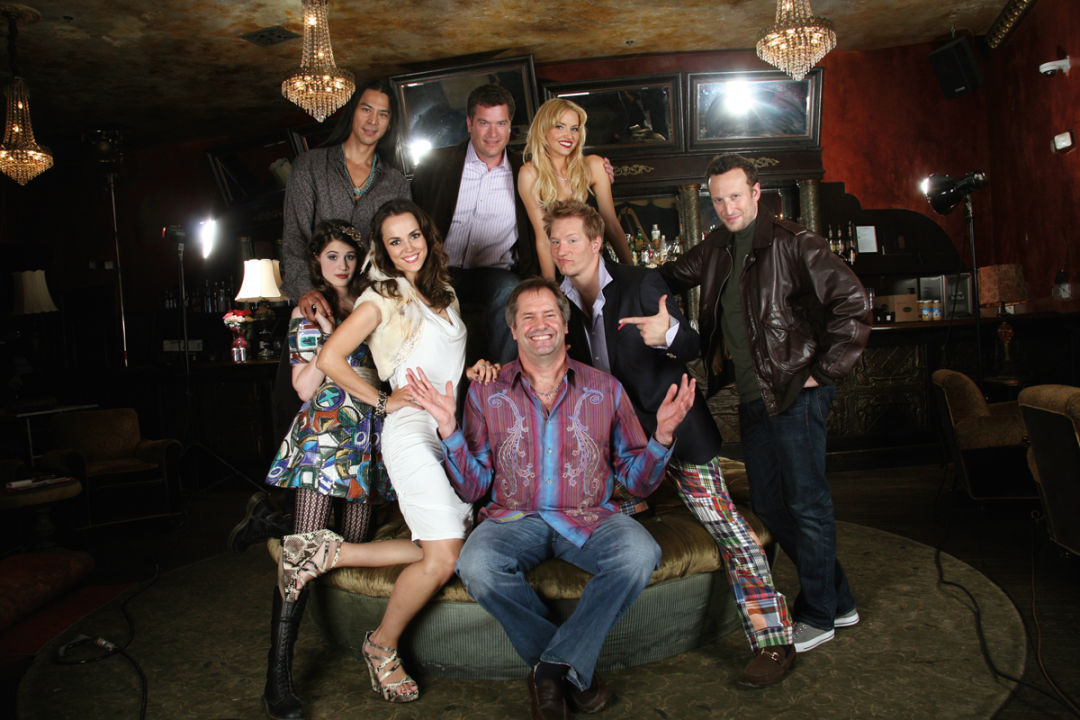
Simmons (front) and the cast of A$pen: The Series
Image: Courtesy: Greg Simmons














































